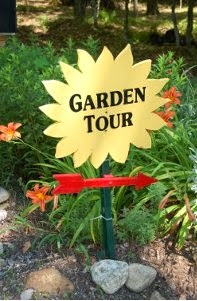Back in February, I was invited
by the Danvers Garden Club to present ‘Gardening Is Murder’ at the organization’s
monthly meeting. As frequently happens,
I spoke at the end of the evening and so had the opportunity to sit through the
club’s business session.
Although the snow was piled high
outside, the primary subject for the evening was planning for ‘Enchanted
Gardens’, a tour of ten member gardens that would not take place for another
four months. This was not a new topic;
rather, this was the final logistics session.
The tickets, garden descriptions and tour map had all been printed. That evening’s discussion was about docents,
refreshments, raffle items and ticket sales.
 |
| The tour program. Double-click to see at full size |
As I listened, I was struck by
both the level of planning for the event and for the assumption that the chosen
date would bring good weather. The
back-and-forth went on for half an hour: a checklist with a list of responsibilities
that ensured nearly every able-bodied member of the club would be pressed into
service.
This past weekend, Betty and I
had the opportunity to see what was wrought by the club. It was beautiful, and was augmented by
falling on one of those ‘ten perfect days of the year’ that never seem to fall
on a Saturday or Sunday.
 |
| The Collins garden is all about color |
Until the 18th
Century, Danvers was part of neighboring Salem and, for the record, the ‘Salem’
witch trials took place in what is now Danvers (many of the historical homes of
the period still stand). It is a town of
older, small houses on village-sized lots, but it also has its share of
estate-sized properties. ‘Enchanted
Gardens’ focused on those small, intimate properties where homeowners
creatively used shrubs and walls to create distinct ‘rooms’ that invited
exploration.
Here are some notes on three of
the ten gardens:
 |
| Eye-catching! |
We started with a suburban
garden, where the Collins family showed they believe in color and unusual plant
selection to make a statement about gardening.
On the front porch was a chartreuse-color container overflowing with yellow,
peach, pink and red calibrochoa. By the garage was a plant stand with pots in
colors of plum, orange, pike and chartreuse.
Though most contained simple petunias or New Guinea impatiens, the overall
effect was to create an entire, memorable wall of color. The garden also incorporates some cultivars
with which I was unfamiliar, such as a Delphinium
‘Summer Blues’ that trades the larkspur’s usual stake-it-or-else flower spikes
for a mound of beautiful blue flowers.
 |
| The Skane garden was about texture |
Any garden that features a table
laid out with freshly made mimosas gets a ‘thumbs up’ from me, but the small
village garden of Ian Skane would have been memorable even without drinks. The guide indicated this was the garden of “Melanie
and Ian Skane” but Ian immediately acknowledged that he is the gardener and not
his spouse. His co-gardener is his mother, who was also on hand to talk about
the property. She is English by birth
and grew up with gardens; she transmitted that love of growing things to her
son.
 |
| Geometry plus color at the Sanborn garden |
The Skane garden uses a fence to
divide one planting area visible from the street from other, more private
places to the side and rear of the home.
Much of the rear garden is shades of green, but with textures and leaf
size providing the drama. The lone
bright bursts of color come from clutches of yellow oenothera, which Ian gleefully says he pulls out by the armload
after the bloom passes.
 |
| At the foot of the verandah, a vegetable garden |
Kathy and David Sanborn have a
home on the part of town that touches the Danvers River leading into Beverly
Harbor. The home is gracious and, down a
glorious geometric stone and gravel walkway lined with hosta and hydrangea,
there’s a wonderful verandah. And what
is at the base of the verandah is anything but the expected: there’s a beautiful, working vegetable garden
in raised beds. There are also containers
overflowing with flowers at every turn.
This is a home where every square foot of the property has been thought
through.
 |
| Bright containers overflowing |
There is a purpose to all the
hard work that members of the garden club went through to make that day
happen. I learned that more than 300
tickets were sold (at $20 for advance purchases and $25 on the day of the
tour). Tours also incur expenses, but it would not be unreasonable to conclude that the club netted several thousand dollars for its considerable effort.
And what does the club do with
that money? Give it away, mostly, by re-investing it in the community. The balance of that business meeting I sat
through in February was about planting sites around the town, scholarships
awarded, donations to garden-related causes, and garden therapy at area nursing
homes. I would guess that virtually
every dime raised for the tour gets put back into making Danvers a more attractive
place to live.
So the next time you see a clutch
of balloons and a sign saying ‘garden tour this way’, take an hour or two out
of your schedule and go help a worthy cause.
It’s a little beauty that may brighten your day.



Neal, when we were living in England we always took advantage of "Open Garden" days. It was a chance to see something new and make note of ideas. I loved the fact that the "mother of the gardener" at the Skanes was a Brit. They do love their gardens. It sounds like the Sanborn garden was an inspiration. And I loved the Collins' use of colorful pots. Thanks so much for the tour!
ReplyDelete